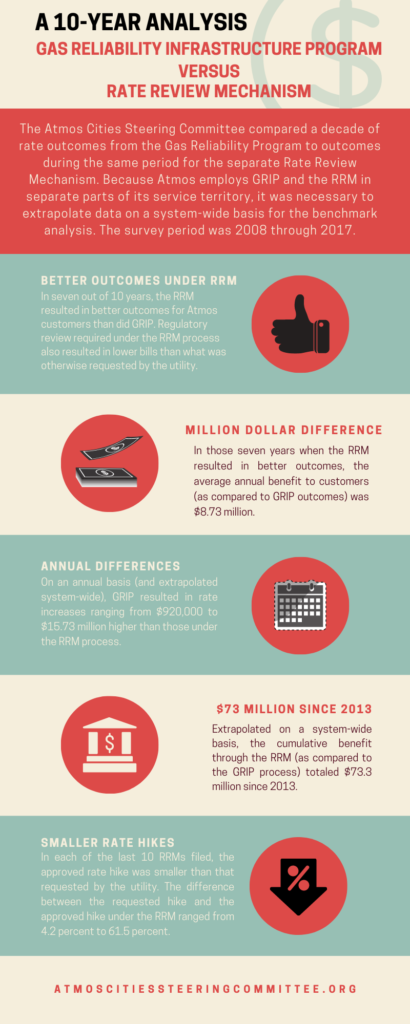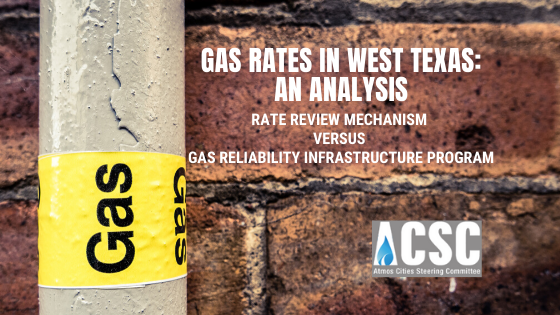Atmos Energy filed a new RRM request to increase annual rates by $16.8 million system-wide in its West Texas service territory, and about $7.1 million of that request would be applicable to ACSC member cities.
________________________________________________
Early in 2019 we released an analysis of two important rate-setting mechanisms employed by the Atmos gas utility. One, the Gas Reliability Infrastructure Program (GRIP), was created by the Texas Legislature; the other, the Rate Review Mechanism, (RRM) does not exist in statute but rather is the result of various covenants reached between the Atmos utility and participating member governments of the Atmos Cities Steering Comm ittee (ACSC).
ittee (ACSC).
Both GRIP and the RRM permit Atmos to hike rates on an annual basis. However, under GRIP, Atmos can effectuate these hikes without any contemporaneous and substantive regulatory review. This means that under GRIP, Atmos (or any other utility that employs it) can increase rates without consideration of offsetting savings, without consideration of revenue levels — without even consideration of the prudence of their underlying investments.
The RRM, by contrast, requires utilities to submit their rate requests to regulatory scrutiny, sets forth various deadlines for expedited reviews, and allows for an examination of various mitigating factors that can limit rate hikes and potentially save money for Texas gas consumers.
Atmos, which serves about 2 million customers in north, central and west Texas, employs the RRM only in areas falling within the boundaries of ACSC cities. It employs GRIP in those sections of its service territory lying outside the territorial boundaries of ACSC cities and within some non-ACSC cites. Under GRIP, utilities can hike rates once per year for six years before submitting to a more thorough rate case at the Texas Railroad Commission.
Recently, Atmos Energy filed a new RRM request to increase annual rates by $16.8 million system-wide in its West Texas service territory, and about $7.1 million of that request would be applicable to ACSC member cities. An adjustment to the utility’s request to make it comply with RRM restrictions reduced that portion applicable to West Texas ACSC cities by $500,000 — or to $6.6 million. ACSC consultants and lawyers will now review the company’s RRM filing in an attempt to reduce that $6.6 million even further.
As noted above, Atmos Energy typically applies GRIP rules to its rate quests for areas outside of municipal limits. The cities of Lubbock and Amarillo also have chosen to continue using the GRIP process. Our analysis shows that our ACSC member cities in West Texas that have employed RRM have historically negotiated better rates for their citizens than have those jurisdictions that employ GRIP — and this new filing further confirms those findings.
Consider the following data points: On April 28 — that is, in just a few weeks — Amarillo and Lubbock residential consumers will begin paying revised customer charges of $27.67 per month because of new GRIP filings there. The proposed RRM customer charge for ACSC cities, by contrast, will be no more than $17.50. While separate consumption charges are higher for West Texas cities under RRM than they are for Lubbock and Amarillo under GRIP, West Texas residential consumers nonetheless will maintain an $0.82 monthly advantage over Amarillo residential customers and a $2.07 monthly advantage over Lubbock residential customers at the same level of consumption. The comparative advantages of RRM will increase if ACSC consultants and lawyers manage to further reduce the company’s $6.6 million rate request.

